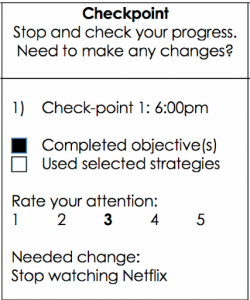Optimizing Attention: A Guide for Effective Study Plans
By a Learning Center Peer Tutor
Have you ever felt the desire to do anything but study, especially when you have an exam coming up? I can relate. That was me this week. Anything seemed better than sitting down and being productive. I had to somehow get out of my procrastination zone and into the study zone. To do that, I decided to try the Optimizing Attention worksheets from the Learning Center–I was amazed by how effective they were. I was able to re-think my study conditions and make a study plan that helped me thrive.
First, I filled out Part 1. This first worksheet helped me identify the conditions that are most conducive to my learning. For example, I can study only in complete silence or with light classical music in the background, because music with lyrics tends to distract me. The worksheet also helped me identify signs that I may be off task, such as when I re-read a sentence multiple times. It even encouraged me to consider things to avoid during my breaks, including watching Netflix or going on social media. By putting these thoughts down into words, I was able to recognize and articulate my ideal study conditions. Even though I already had a good idea of my preferences, writing them down made me acknowledge them and made me create a better studying environment.

After filling out all the lists in the worksheet, I knew how I wanted to study and under what conditions. But I still needed something to help me with time management. Before the shift to remote learning, and when I put my mind to it, I was extremely productive for long periods of time. The shift to online classes has been trying, though, especially because I have to study in my room and can no longer visit Davis Library. Without a change in scenery, I find myself struggling to escape my distractions.
To help me overcome these “attention blockers,” I opened Part 2, the second worksheet in the series. By filling it out, I implemented a study plan and tracked my progress. I had three study objectives: first, to take the practice exam; second, to go through the practice exam answer key and clarify misconceptions; and third, to make a sheet with important concepts as a reference during open-notes exams.
What helped me actually sit down and study was the section of the worksheet that asked me to designate checkpoint times for each of my objectives. I had never done this before. I always had tasks in mind, and I would study for as long as I needed to accomplish them. With this new arrangement, I had to complete the practice exam by 6 PM, clarify my misconceptions by 7 PM, and fill out my concept sheet by 10 PM. I structured these tasks this way so that I had more than enough time to accomplish my goals without enough time to slack off. By having a certain task that needed to be finished by a certain time, I found myself staying extra focused to get everything done. This was definitely my favorite feature of the worksheets.

The worksheet asked me to rate my attention after completing each checkpoint, a component that helped me notice my progress. When I was done with the first checkpoint and had been productive only for a little while, I rated my attention a 3. But the more I followed the plan, the more engaged I became, and the more accomplished I felt. My attention went from 3 to 4 to 5. Having these specific, actionable goals to focus on, and seeing myself succeed, gave me more desire to follow through with them.
At the end, the worksheet gave me space to reflect on my session. I wrote down what worked for me, such as putting my phone and computer in a different room as I studied. The study session was not completely perfect, as I did get distracted in the beginning and watched Netflix. Still, I was able to get back on track and focus due to my desire to finish the objectives by their checkpoint times. Following these objectives add other benefits, too. Once I finished studying, I went to bed much earlier than usual. Success!
Overall, I was very pleased. I reflected on my ideal study scenario, made a study plan, and followed it successfully. Moreover, checking the boxes for each objective in the worksheet was beyond satisfying. I will definitely be using these worksheets in the future, and I recommend them to anyone who is having a hard time sticking to a study plan.
This blog showcases the perspectives of UNC Chapel Hill community members learning and writing online. If you want to talk to a Writing and Learning Center coach about implementing strategies described in the blog, make an appointment with a writing coach or an academic coach today. Have an idea for a blog post about how you are learning and writing remotely? Contact us here.

